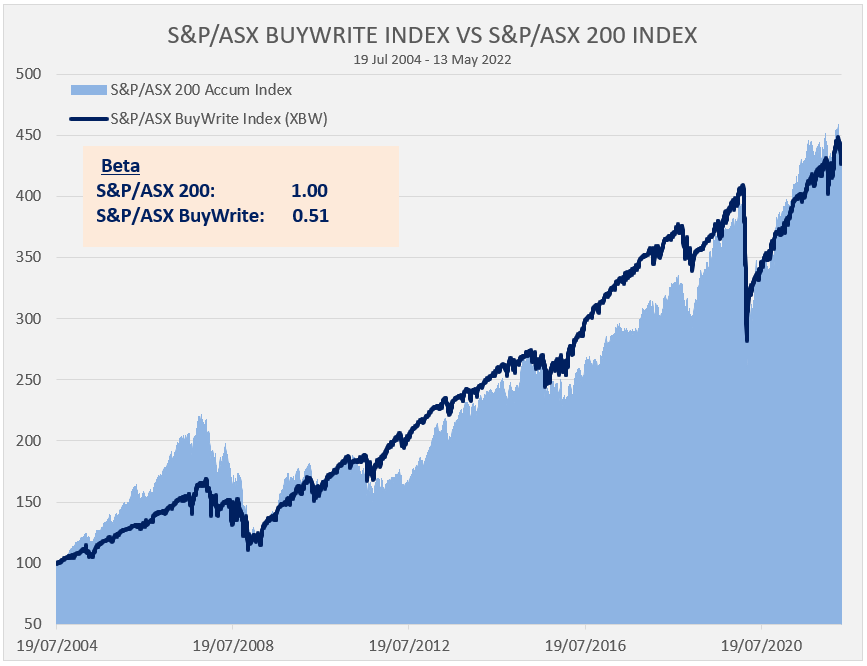Want to keep your dividends but reduce risk?
As market returns trend lower, many investors are waking up to the underlying risk in their portfolios. In recent years as interest rates have marched steadily towards zero, investors who rely on income have been forced further out along the risk curve in order to generate sufficient yield.
As a result, cash weightings for many investors are down and equity weightings are up… meaning overall portfolio risk is meaningfully higher. Hardly ideal as we potentially head into an economic slowdown, but there have been few other solutions for income starved investors.
Is there another way to capture full dividend yields, including full capital returns, but with less risk?
In this wire, we’ll introduce a systematic approach that for the past 18 years has captured the full dividend yield of the Australian market, and full equity returns, but has achieved this with around half the Beta (or risk) of the market. Later we’ll also introduce our Australian fund that uses this source of superior risk-adjusted returns to target alpha, or outperformance.
Equity returns for half the risk? Any way you cut it this spells superior risk-adjusted returns
Introducing the S&P/ASX 200 BuyWrite Index (XBW)
The S&P/ASX 200 BuyWrite Index (XBW) was created by the ASX in 2004 to track the return of a systematic BuyWrite strategy, perhaps the best known of all options trading strategies. For the past 18 years, the XBW has delivered similar equity returns to the S&P/ASX200, including full dividend capture, but for a Beta of around half the broader market.

We’d highlight that ‘Beta’ is a relative measure of risk (relative to the market) and that there are other measures of risk which are also meaningful such as volatility and drawdown. On these measures as well, the XBW Index screens as lower risk versus owning the market. For example, year to date (13/5/22), the XBW Index is positive +0.7%, versus the S&P/ASX 200 Accum Index which is down -5.2%.
How does it work?
The XBW owns all the shares in the S&P/ASX200 and enjoys all the benefits of share ownership, including receiving fully franked dividends (franking values are not included in the above chart). In addition, the strategy sells a 3-month at-the-money Index call option over the entire equity position. The option position is held to expiry each quarter, before being reset and a new 3-month at-the-money option is sold.
What is a call option? A call option provides the buyer with the right, but not the obligation, to buy shares at a point in the future. In a BuyWrite strategy call options are sold, which generates income and reduces risk, but forgoes capital upside should markets rally.
The returns of the strategy in a positive market consist solely of the option premium that is received each time the quarterly option is sold along with dividend income. In down markets, the covered call also provides an element of risk reduction, along with the receipt of dividend income. Through the cycle, these characteristics combine to effectively halve the risk relative to owning the ASX200 Index outright from a Beta perspective.
At Wheelhouse we have long been intrigued by the risk reduction properties of systematic Index-based overlay strategies, to the point where they serve as the foundation for all our investment strategies.
What is the XBW strategy exploiting?
When call options are sold the premium received is influenced by the market’s expectations of future price movements in the ASX200. This is otherwise known as implied volatility. Historically, implied volatility has been consistently higher than actual or realised volatility, which is the actual price movement in the ASX200 over the period.
This difference between implied volatility and realised volatility, is known as the volatility risk premium, and is an integral component in the returns of systematic option selling strategies.
What can go wrong?
The XBW owns a full portfolio of equities and is taking some equity risk. Should the market fall 10% or 20% overnight, the Index would wear most (but not all) of this decline. The difference is due to the receipt of option premium from the sold calls which helps reduce losses in a drawdown.
From a relative return perspective, BuyWrite strategies are likely to underperform an equivalent equity portfolio in strongly rising markets but outperform in lower growth or declining markets.
Higher returns for the risk
By yielding equity returns through the cycle whilst only assuming approximately half the risk, it is fair to say that the BuyWrite Index has delivered very strong risk-adjusted returns.
To put it another way, the return per unit of risk (Beta) is almost double owning the ASX200 index itself. This strong risk-adjusted return is reflected in elevated Sharpe ratios and is broadly consistent with characteristics evident in other systematic overlay strategies globally.
For many investors with a lower risk tolerance, but who still wish to receive full dividend yields along with equity returns, this return profile may be the perfect building block in terms of constructing a lower-risk equity portfolio. We would caution all investors about using derivatives without the appropriate risk management tools and trading experience. Our Global fund applies this lower risk approach to a portfolio of Global shares, targeting a yield of 7-8% for around half the Beta of the market.
One step further - Converting strong risk-adjusted returns into alpha
However, for those investors willing to assume full market risk, we were intrigued to see what impact leveraging the underlying portfolio had on returns. With the XBW strategy generating high risk-adjusted returns, we believed adding some gearing would deliver alpha or market-beating returns.
Hence the conception of the Wheelhouse Australian Enhanced Income Fund - where we use the same underlying principle of the XBW Index, however, we internally gear the underlying equity exposure so that risk matches that of the S&P/ASX200 index (ie a Beta of 1).
With risk matched, the Fund targets 2-3% in outperformance without the need for stock picking or market timing. In addition, investors benefit from up to double the fully franked yield of the market.
Can the Fund be used to reduce risk?
For income investors who are looking to reduce risk, the Australian Fund targets a fully-franked yield of twice the market. This may allow investors to reduce their overall equity exposure, yet still achieve a similar income objective. With yields on cash still low (but likely rising), reducing overall equity exposure will free up some capital to re-weight back into the safest of all asset classes, cash.
Separately, for investors more focused on relative outperformance, the strategy targets alpha from a completely different source versus most other strategies that rely on stock picking. As the primary mechanism for reducing risk in the strategy (the overlay) also generates income, this additional return source forms the basis for outperformance of the benchmark.
Looking for a unique source of income-driven alpha?
For investors seeking a completely unique source of income-driven alpha for their portfolios, plus a targeted yield of up to 2x the market, the Wheelhouse Australian Enhanced Income Fund may be worth a look.
Please click here to find out more
Read more articles from Wheelhouse Partners by clicking on the headlines below.
.png)
.png)
5 topics

